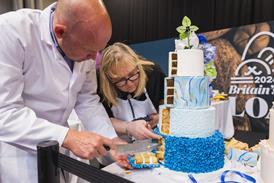John Watts works as senior technologist at ingredients supplier to the baking industry, National Starch Food Innovation. He formerly worked as process manager for British Bakels. Now, clearly relishing his new role, he takes us through a typical day.
6am
Most people won’t believe me when I say this, but I actually look forward to waking up every morning. The reason? My breakfast.
Having a girlfriend who teaches catering is handy. She’s always keen to know what’s going on in the ingredients world. I sometimes bring back samples of our resistant starch for her to try out new recipes. She repays the favour by baking trays of muffins for me to share around the office.
The usual morning routine ensues: an hour in the gym to activate my mind and body and then a half-hour drive to work, with the radio blaring. It’s the morning after the night before and I need to get the lowdown on the rugby scores.
8.30am
With the whole week ahead, there’s a lot of preparation to do: samples to make, meetings to organise and problems to solve. A hectic schedule seems to be an intrinsic part of life in the baking industry.
Today I’m in the lab, baking-off products with our resistant starch Hi-maize. Muffins and cookies are firm consumer favourites. In the past, these have suffered a less-than-healthy reputation, causing more and more people to turn their backs on baked goods. But Hi-maize can help to reverse this trend.
The nutritional benefits of Hi-maize in baked goods are easy to explain: it increases fibre without changing taste or texture; can help keep your digestive system healthy and much more. But, it’s one thing telling customers about its product attributes, and another being able to demonstrate them. We usually add between 15-40% to replace flour, depending on the application and claims required. Often, we make up a selection of samples - some baked with Hi-maize, some without. We then open up the texture debate, asking customers to guess which ones contain the resistant starch and which don’t. Invariably they can’t decide.
Work is a true passion for me. You could say it’s in my genes. My mother and grandmother both worked in the catering industry, so I’ve been involved all my life. As a result, for me, taste, texture and mouthfeel are all important.
1pm
The morning flies by and I’m glad when lunchtime arrives - time for a well-earned break and a chat about last night’s game.
I return to the office and pick up some messages - a sample request and a customer re-scheduling a meeting. I settle at my desk to return calls and respond to my e-mails. With administration over, I gather my things and set off to see a customer. On the way, I call the team back in Manchester to check everything’s running smoothly in the lab.
2.30pm
Travelling is part and parcel of my job and I’ve grown to enjoy it in the last few months. Face-to-face contact with customers is key. It’s the best way to really get to know their business and highlight how we can help them.
We don’t just meet development teams though. We’ve come to realise that communication with the marketing team is equally important. They need to know what resistant starch is all about and how, with its multiple benefits, it can enrich a product’s marketing strategy.
The ’potential’ customer I’m visiting today, a major player in the baking industry, wants to know more about resistant starch, its role and how it can add value to the firm’s bakery products. I talk them through possible positioning strategies, emphasising the main features and benefits.
3.30pm
Back on the road to see another customer. Earlier today we received a call from a baker with formulation issues. He had incorporated Hi-maize at the same rate as wheat flour and added too much water to the mix, creating problems for the dough rheology. My role, as senior technologist, is to come up with a solution tailored to the customer’s needs. Technical support is a large part of the package that National Starch Food Innovation offers and covers ingredient selection, formulations advice, product trials, legislative guidance and labelling.
5pm
Customer visits over, I’m usually back at the office writing up a report of the day’s activity and planning for tomorrow. I flick through the small pile of magazines in my in-tray to keep abreast of developments in the food industry. Then I answer a few more e-mails, catch up with the other ’techies’ and finally shut down my computer.
6pm
On my way out, I put a sponsorship form in everyone’s in-tray. Together with some colleagues, I’m doing a sponsored diet for Francis House Children’s Hospice, a Manchester-based charity offering families of sick children respite from their role as carers. National Starch Food Innovation has generously agreed to contribute one pound for every pound we collectively lose.
On the way home I get a call requesting my attendance at the local pub quiz. When I arrive, there’s a pint waiting for me - not altogether in keeping with my new diet, but still a welcome and relaxing end to a hectic day. n


























No comments yet